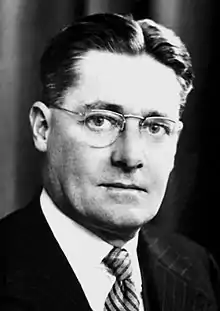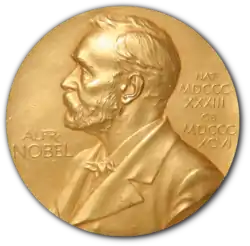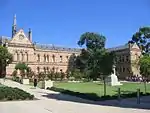Howard Florey
Howard Walter Florey, Baron Florey of Adelaide and Marston OM FRS FRCP (24 September 1898 – 21 February 1968) was an Australian pharmacologist and pathologist who shared the Nobel Prize in Physiology or Medicine in 1945 with Sir Ernst Chain and Sir Alexander Fleming for his role in the development of penicillin.
The Lord Florey of Adelaide and Marston | |
|---|---|
 | |
| Born | Howard Walter Florey 24 September 1898 Adelaide, South Australia, Australia |
| Died | 21 February 1968 (aged 69) Oxford, England |
| Nationality | Australian |
| Education | Scotch College, Adelaide, St Peter's College, Adelaide |
| Alma mater | University of Adelaide Magdalen College, Oxford Gonville and Caius College, Cambridge |
| Known for | Discovery of penicillin |
| Awards | Fellow of the Royal Society (1941)[1] Cameron Prize for Therapeutics of the University of Edinburgh (1945) Nobel Prize in Physiology or Medicine (1945) Lister Medal (1945)[2] Knight Bachelor Albert Medal (1946) Royal Medal (1951) Copley Medal (1957) Lomonosov Gold Medal (1965) Wilhelm Exner Medal (1960) |
| Scientific career | |
| Fields | Bacteriology, immunology |
| Institutions | University of Adelaide University of Oxford University of Cambridge University of Sheffield Australian National University |
| Influences | Charles Sherrington[3] |
Although Fleming received most of the credit for the discovery of penicillin, it was Florey who carried out the first ever clinical trials of penicillin in 1941 at the Radcliffe Infirmary in Oxford on the first patient, a police constable from Oxford. The patient started to recover, but subsequently died because Florey was unable, at that time, to make enough penicillin. It was Florey and Chain who actually made a useful and effective drug out of penicillin, after the task had been abandoned as too difficult.
Florey's discoveries, along with the discoveries of Fleming and Ernst Chain, are estimated to have saved over 200 million lives,[4] and he is consequently regarded by the Australian scientific and medical community as one of its greatest figures. Sir Robert Menzies, Australia's longest-serving Prime Minister, said, "In terms of world well-being, Florey was the most important man ever born in Australia."[5]
Early life and education
Howard Florey was born in Malvern, a southern suburb of Adelaide, South Australia, the youngest of three children and the only son.[5] His father, Joseph Florey, was an English immigrant, and his mother Bertha Mary Florey was a second-generation Australian.[6][1]:255
Florey was educated at Kyre College Preparatory School (now Scotch College) and then St Peter's College, Adelaide,[1] where he excelled in chemistry and physics, but not mathematics.[7] He also played various sports for the school: cricket, football, athletics, and tennis.[1]:255 He studied medicine at the University of Adelaide from 1917 to 1921, paid entirely by a state scholarship he had achieved.[7]
Florey continued his studies at Magdalen College, Oxford as a Rhodes Scholar under the tutelage of Sir Charles Scott Sherrington, receiving the degrees of BA in 1924 and MA in 1935.[5] In 1925, he left Oxford to attend the University of Cambridge, during which time he won a fellowship from the Rockefeller Foundation and studied in the United States for ten months. He returned to England in 1926 and was elected to a fellowship at Gonville and Caius College, Cambridge, and a year later he received the degree of PhD.[1]:258–259

Career
After Cambridge, Florey was appointed to the Joseph Hunter Chair of Pathology at the University of Sheffield in 1932. In 1935 he returned to Oxford, as Professor of Pathology and Fellow of Lincoln College, Oxford, leading a team of researchers. Working with Ernst Boris Chain, Norman Heatley and Edward Abraham, he read Alexander Fleming's paper discussing the antibacterial effects of Penicillium notatum mould.[1]:260–262
In 1941, he and Chain treated their first patient, Albert Alexander, who had had a small sore at the corner of his mouth, which then spread, leading to a severe facial infection involving streptococci and staphylococci. His whole face, eyes and scalp were swollen to the extent that he had had an eye removed to relieve the pain. Within a day of being given penicillin, he started to recover. However, the researchers did not have enough penicillin to help him to a full recovery, and he relapsed and died. Because of this experience and the difficulty in producing penicillin, the researchers changed their focus to children, who could be treated with smaller quantities of penicillin.[8]
Florey's research team investigated the large-scale production of the mould and efficient extraction of the active ingredient, succeeding to the point where, by 1945, penicillin production was an industrial process for the Allies in World War II. However, Florey said that the project was originally driven by scientific interests, and that the medicinal discovery was a bonus:[9]
People sometimes think that I and the others worked on penicillin because we were interested in suffering humanity. I don't think it ever crossed our minds about suffering humanity. This was an interesting scientific exercise, and because it was of some use in medicine is very gratifying, but this was not the reason that we started working on it.[10]
— Howard Florey
Developing penicillin was a team effort, as these things tend to be.[11]
— Howard Florey
Florey shared the Nobel Prize in Physiology or Medicine in 1945 with Ernst Boris Chain and Alexander Fleming. Fleming first observed the antibiotic properties of the mould that makes penicillin, but it was Chain and Florey who developed it into a useful treatment.[12]
In 1958 Florey opened the John Curtin School of Medical Research at ANU in Canberra. In 1965 the Queen made him Lord Florey and he was offered, and accepted, the role of Chancellor of the Australian National University.[13]
Honours and awards
On 18 July 1944 Florey was appointed a Knight Bachelor.[14][15] In 1947 he won the Gold Medal of the Royal Society of Medicine.[16]
He was awarded the Cameron Prize for Therapeutics of the University of Edinburgh and the Lister Medal in 1945, for his contributions to surgical science.[2] The corresponding Lister Oration, given at the Royal College of Surgeons of England later that year, was titled "Use of Micro-organisms for Therapeutic Purposes".[17] In 1946, the University of Sao Paulo awarded him an honorary doctorate.[18]

Florey was elected a member of the Royal Society in 1941 and became president in 1958.[1] In 1962, Florey became Provost of The Queen's College, Oxford. During his term as Provost, the college built a new residential block, named the Florey Building in his honour. The building was designed by the British architect Sir James Stirling.
On 4 February 1965, Sir Howard was created a life peer and became Baron Florey, of Adelaide in the State of South Australia and Commonwealth of Australia and of Marston in the County of Oxford.[19] This was a higher honour than the knighthood awarded to penicillin's discoverer, Sir Alexander Fleming, and it recognised the monumental work he had done in making penicillin available in sufficient quantities to save millions of lives in the war, despite Fleming's doubts that this was feasible. On 15 July 1965 Florey was appointed a Member of The Order of Merit.[20]
Florey was Chancellor of the Australian National University from 1965 until his death in 1968. The lecture theatre at the John Curtin School of Medical Research was named for him during his tenure at the ANU.
Posthumous honours and legacy

Florey's portrait appeared on the Australian $50 note for 22 years (1973–95),[21] and the suburb of Florey in the Australian Capital Territory is named after him.[22] The Florey Institute of Neuroscience and Mental Health, located at the University of Melbourne, Victoria,[23] and a lecture theatre in the University of Adelaide's medical school are also named after him.[24] The defunct Australian Student Prize, given to outstanding high-school leavers, was previously called the "Lord Florey Student Prize" in recognition of Florey.[25]
The Florey Unit of the Royal Berkshire Hospital in Reading, Berkshire, is named after him.[26]
The Florey Institute for Host–Pathogen Interactions at the University of Sheffield is named in his honour.[27]
The Florey Science Centre at St Peter's College, Adelaide is named after him, as he attended the college. It was opened post 1950. The building facilitates science classes for students from Year 7 to Year 12. On the lowest floor's concourse there is a commemorative statue and plaque.
Personal life
At the University of Adelaide, he met Ethel Reed (Mary Ethel Hayter Reed), another medical student, who became both his wife and his research colleague. They had two children: Paquita Mary Joanna and Charles du Vé.[15][28] After the death of his wife Ethel, he married in 1967 his long-time colleague and research assistant Margaret Jennings (1904–1994). He died of a congestive heart failure in 1968 and was honoured with a memorial service at Westminster Abbey, London.
Florey was an agnostic.[29]
In film
Penicillin: The Magic Bullet is a 2006 Australian film production written by Gordon Glenn and financed by the Film Finance Corporation and Arcimedia Productions in association with Film Victoria.[30] Breaking the Mould is a 2009 historical drama that tells the story of the development of penicillin in the 1930s and '40s, by the group of scientists at Oxford headed by Florey at the Dunn School of Pathology. The film stars Dominic West as Florey, Denis Lawson, and Oliver Dimsdale; and was written by Kate Brooke and directed by Peter Hoar.
References
- Abraham, E. P. (1971). "Howard Walter Florey. Baron Florey of Adelaide and Marston 1898-1968". Biographical Memoirs of Fellows of the Royal Society. 17: 255–302. doi:10.1098/rsbm.1971.0011. PMID 11615426. S2CID 29766722.
- "Sir Howard Florey, F.R.S.: Lister Medallist". Nature. 155 (3942): 601. 1945. Bibcode:1945Natur.155R.601.. doi:10.1038/155601b0.
- Todman, Donald (2008). "Howard Florey and research on the cerebral circulation". Journal of Clinical Neuroscience. Elsevier. 15 (6): 613–616. doi:10.1016/j.jocn.2007.04.017. PMID 18280740. S2CID 40353145.
His mentor was the neurophysiologist and Nobel Laureate, Sir Charles Sherrington who directed him in neuroscience research. Florey's initial studies on the cerebral circulation represent an original contribution to medical knowledge and highlight his remarkable scientific method. The mentorship and close personal relationship with Sherrington was a crucial factor in Florey's early research career.
- Woodward, Billy. "Howard Florey-Over 6 million Lives Saved." Scientists Greater Than Einstein Fresno: Quill Driver Books, 2009 ISBN 1-884956-87-4.
- Fenner, Frank (1996). "Florey, Howard Walter (Baron Florey) (1898–1968)". Australian Dictionary of Biography. vol. 14. Melbourne University Press. pp. 188–190. Retrieved 10 October 2008.
- Quirke, Viviane M. (2001). "Florey, Howard Walter". Encyclopedia of Life Sciences. doi:10.1038/npg.els.0002792. ISBN 9780470016176.

- Lax, Eric (2 June 2015). The Mold in Dr. Florey's Coat: The Story of the Penicillin Miracle. Henry Holt and Company. pp. 43–45. ISBN 9781627796446.
- MacFarlane, Gwyn (1979). "The proving of penicillin". Howard Florey : the making of a great scientist. Oxford: Oxford University Press. pp. 327–346. ISBN 9780198581611.
- Sutherland, Denise (28 January 1998). "Howard Florey". Australasian Science. University of Melbourne. Retrieved 21 February 2019.
- Sutherland, Denise; Tenkate, Elissa (19 February 1998). "Howard Walter Florey". Australian Nobel Laureates. University of Melbourne. Retrieved 21 February 2019.
- Turnidge, John (2013). "Howard Florery Oration" (PDF). Breakpoint. Australian Society for Antimicrobials. p. 3. Retrieved 21 February 2019.
- Judson, Horace Freeland (20 October 2003). "No Nobel Prize for Whining". The New York Times. Retrieved 23 June 2010.
- "Lord Howard Florey OM FRS FRCP". About: Our history. Australian National University. n.d. Retrieved 12 April 2018.
- "No. 36620". The London Gazette. 21 July 1944. pp. 3415–3416.
- Sir Howard Florey on Nobelprize.org
 including the Nobel Lecture, December 11, 1945 Penicillin
including the Nobel Lecture, December 11, 1945 Penicillin - Moore, George. The Creators.
- Florey, H. W. (1945). "Use of Micro-organisms for Therapeutic Purposes". BMJ. 2 (4427): 635–642. doi:10.1136/bmj.2.4427.635. PMC 2060276. PMID 20786386.
- Honorary Doctorates between the decades of 1940s and 1950s from the University of Sao Paulo, Brazil
- "No. 43571". The London Gazette. 9 February 1965. p. 1373.
- "No. 43713". The London Gazette. 16 July 1965. p. 6729.
- "Inflation and the Note Issue". Reserve Bank of Australia Museum. Reserve Bank of Australia. Archived from the original on 27 April 2016. Retrieved 31 December 2015.
- "Place name search". ACT Environment and Sustainable Development. Retrieved 11 January 2013. (not possible to link directly to search results)
- "About Us | History". The Florey. Retrieved 14 February 2019.
- "North Terrace Campus Map" (PDF). University of Adelaide. Retrieved 14 February 2019.
- "Nobel Laureates". University of Adelaide. Retrieved 14 February 2019.
- Sexual Health Department Archived 21 October 2009 at the Wayback Machine. royalberkshire.nhs.uk
- "The Florey Institute". University of Sheffield. Retrieved 14 February 2019.
- Fenner, Frank. "Florey, Mary Ethel Hayter (1900–1966)". Mary Ethel Hayter Florey. Australian Dictionary of Biography. National Centre of Biography, Australian National University.
- Trevor Illtyd Williams (1984). Howard Florey, Penicillin and After. Oxford University Press. p. 363. ISBN 978-0-19-858173-4.
As an agnostic, the chapel services meant nothing to Florey but, unlike some contemporary scientists, he was not aggressive in his disbelief.
- Glenn, Gordon. Penicillin: The Magic Bullet.
Further reading
- York, Barry (September 2001). "Howard Florey and the development of penicillin". National Library of Australia News. XI (12): 18–20. Archived from the original on 20 January 2012.
External links
- Sir Howard Florey on Nobelprize.org
 including the Nobel Lecture, December 11, 1945 Penicillin
including the Nobel Lecture, December 11, 1945 Penicillin
| Academic offices | ||
|---|---|---|
| Preceded by John Cockcroft |
3rd Chancellor of the Australian National University 1965 – 1968 |
Succeeded by H. C. Coombs |
| Professional and academic associations | ||
| Preceded by Cyril Norman Hinshelwood |
51st President of the Royal Society 1960–1965 |
Succeeded by Patrick Blackett |

